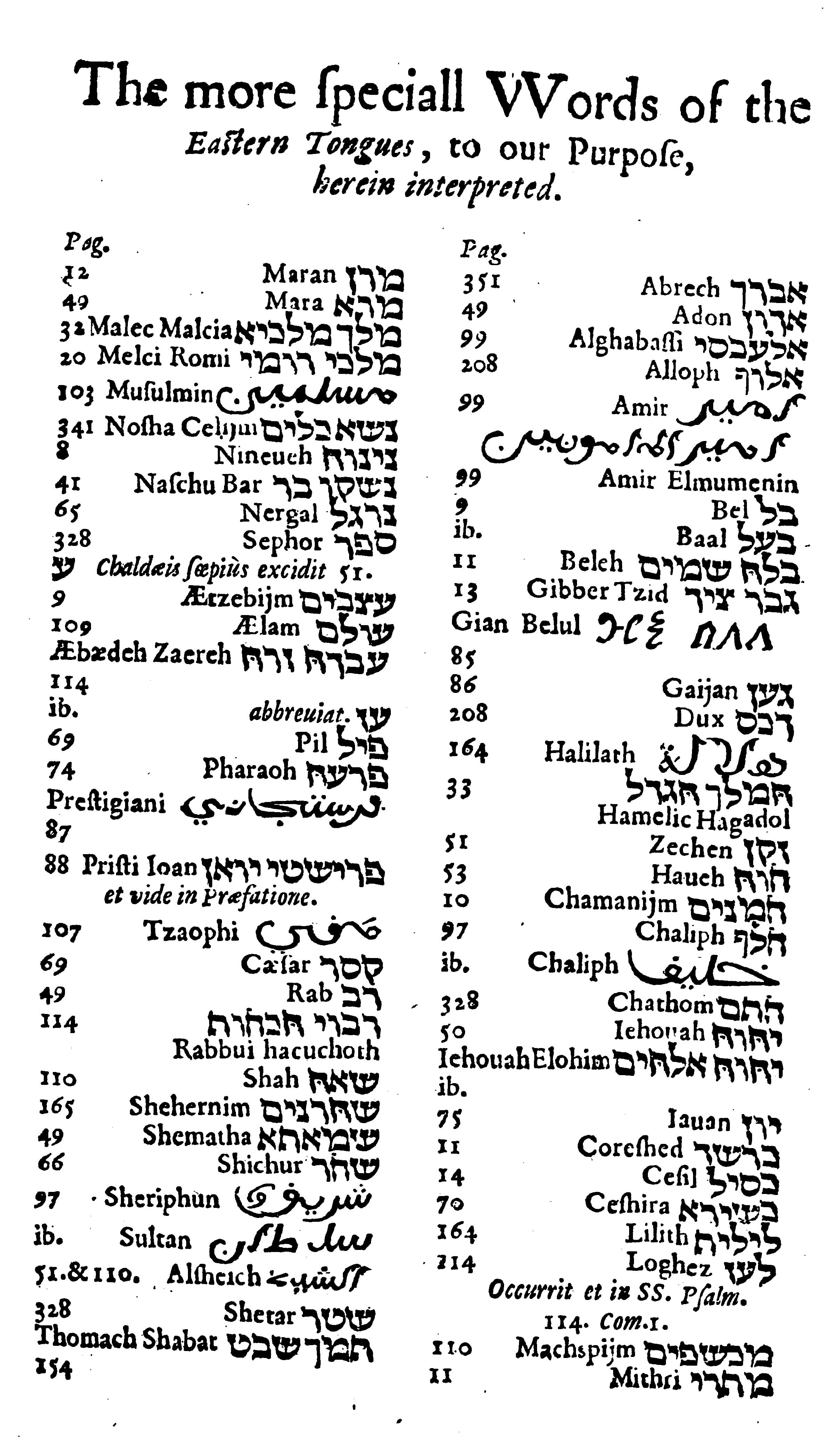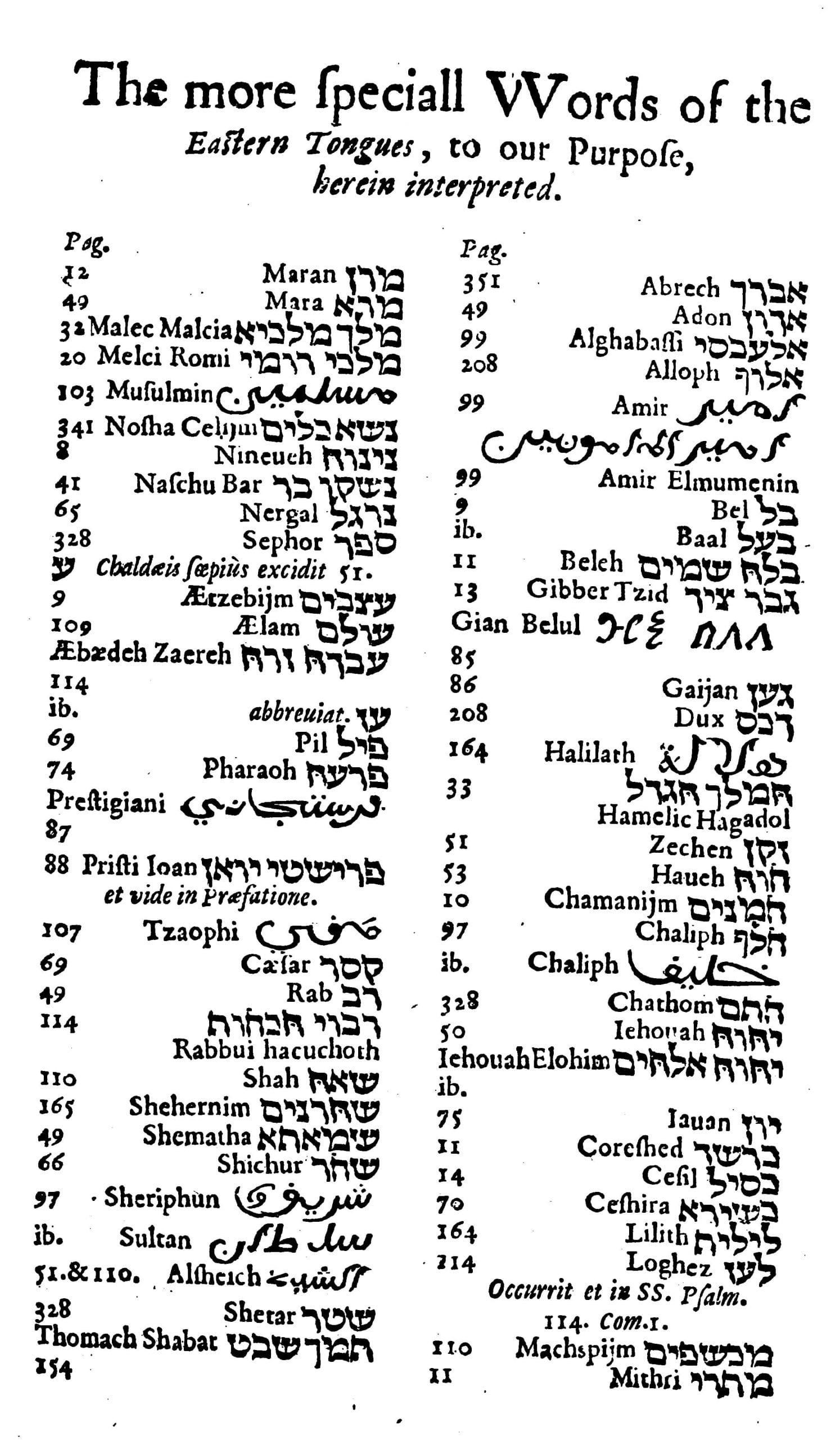by Maryam Patton (April 2015)
In the middle of the ninth century, Paulus Alvarus complained about Spanish Christian youths who were abandoning Latin for the native Arabic of their new conquerors. Yet nearly seven hundred years later, when the last Muslim state of Grenada fell to the Reconquista in 1492, the sustained study of Arabic in Europe suffered a fatal blow. In the following years, royal decrees banning the use of Arabic and book and manuscript burnings, such as the one initiated by Archbishop of Toledo Ximénez de Cisneros in 1499, worked to undo the special relevance Arabic had had for Europeans (Toomer, 17). Until well into the seventeenth century, European interest in the philological pursuit of Arabic waxed and waned. The sources for this interest included the Crusades, scientific knowledge, the rediscovery and transmission of Greek classical texts from Arabic and Syriac translations, and faith-based missions to the Near East. These factors constituted a “first wave” of interest in Arabic study in the medieval period. It was not until a “second wave” of interest beginning in the sixteenth century that Arabic became a sustainable subject for philological inquiry (Russell, 1-19).
This second wave embodied some of the same concerns the original Arabists felt concerning the religious significance of Arabic. In addition to their evangelical missions, early modern students of Arabic sought to reconnect with Eastern Christian communities such as the Maronites and Coptic Christians. In 1584 Pope Gregory XIII founded the hugely successful Maronite College in Rome for the education of Jesuit missionaries traveling East. Meanwhile, growing pressure from the encroaching Ottomans, combined with Ottoman “capitulations” allowing for expanded economic involvement within Ottoman territories, offered economic incentives to study Arabic, as well as Persian and Turkish.
Yet, during the early modern period, an increasing emphasis came to be placed on studying Arabic for its own sake, rather than purely religious or economic concerns. Joseph Scaliger (1540–1609) was one significant example of an early modern scholar who argued for the study of Arabic as an end rather than a means. He stressed the importance of the Koran as a waypoint to understanding Arabic language and culture. His own knowledge of Arabic was limited, but his influence as a professor at Leiden and the example he set for his students ought to be emphasized. Upon his death he bequeathed his impressive library of Oriental manuscripts to the university, helping to establish the Netherlands as one of Europe’s most important centers for the study of Arabic (Toomer, 42-45).
The pursuit of Arabic for its own sake was facilitated by the appearance of printing presses sophisticated enough to print in Arabic using moveable type without relying on crude woodcuts. John Selden’s (1584–1654) 1614 book Titles of Honor for instance relied on woodcuts for the ‘words of the Eastern tongue’ like amir and sultan, but the letters looked strange and often appeared alone when they should instead have been connected to the following letter. In some cases, blanks were left in books where Arabic words were called for and were written in later by hand, like in Richard Brett’s Theses published at Oxford in 1597 (Roper, 12-13).
Proper Arabic type made it possible to finally print grammars and dictionaries. Previously, students had to rely on native speakers and others who already knew the language. The first book containing Arabic printed with moveable type was a book of hours printed in 1514 and intended for use in the near east. Though it was published independently by the Venetian Gregorio de Gregorii, it was paid for by Pope Julius II, and featured odd shapes for some of the letters (cut by Gregorii himself). The characters dal and dhal in particular were too large and should not have curved down below the baseline.


A number of other religious texts intended for Christians in the East appeared soon thereafter, but the most impressive feat was a complete Koran published in 1538 in Venice by Paganino de Paganini and his son Alessandro. It was printed entirely in Arabic without any Latin characters whatsoever in an effort to disguise its Western origins, and was most likely intended for sale in the Ottoman Empire. The Ottomans did not establish their own printing presses for another two hundred years, with the efforts of Ibrahim Müteferrika. Sadly, a lack of demand and the costs associated with creating new Arabic type (not to mention the numerous errors contained therein) bankrupted Paganini. Only one extant copy of this text is known (Nuovo, 79-81).

Italian printing in Arabic reached its height in Rome starting in 1584 with the founding of the Medici Oriental Press by Cardinal Ferdinando de Medici. Pope Gregory XIII again offered his support, and with a newly designed type from the famed typographer Robert Granjon, the Medici Press was in an ideal position to seriously advance Arabic studies. Yet the director, Giovanni Raimondi, grew too ambitious and published many obscure texts with a limited audience. The press faced criticism for its lack of fundamental books such as grammars and basic readers. Few scholars besides those already learned in the language could make much use of these advanced texts, and the press effectively shut down upon Raimondi’s death in 1614. Granjon’s elegant type was, at the very least, saved for later use by the Vatican Press and others, and helped raise the aesthetic standards of Arabic printing. As in the image below, Granjon’s type was far more rectangular than earlier fonts. These instead resembled the curvier handwriting of the manuscripts on which they were based, while Granjon’s type resembles modern Arabic fonts. After the Medici Press ceased operation, the center for Arabic studies shifted to the Netherlands thanks to the diligent efforts of a few key individuals. Scaliger arrived at Leiden in 1593 and swiftly set to work encouraging others to pursue Arabic. His student Thomas Erpenius (1584–1624) was arguably “the first native European to achieve true excellence in Arabic.” Erpenius assumed his position as Professor of Oriental Languages in 1613 and in the same year published his masterful Grammatica Arabica. Its type was cast by Francis Raphelengius, and served as the authoritative grammar for many years to come with several updated editions and the addition of reading passages. Erpenius unfortunately died at the young age of 40, but his student and successor Jacob Golius (1596–1667) carried on in the same vein and produced an Arabic lexicon in 1653. His brother Petrus was then serving in Antioch, and Golius relied on this connection to build an extensive library of Arabic manuscripts rivaled only by Edward Pococke’s collection in England (Toomer, 43-45).
After the Medici Press ceased operation, the center for Arabic studies shifted to the Netherlands thanks to the diligent efforts of a few key individuals. Scaliger arrived at Leiden in 1593 and swiftly set to work encouraging others to pursue Arabic. His student Thomas Erpenius (1584–1624) was arguably “the first native European to achieve true excellence in Arabic.” Erpenius assumed his position as Professor of Oriental Languages in 1613 and in the same year published his masterful Grammatica Arabica. Its type was cast by Francis Raphelengius, and served as the authoritative grammar for many years to come with several updated editions and the addition of reading passages. Erpenius unfortunately died at the young age of 40, but his student and successor Jacob Golius (1596–1667) carried on in the same vein and produced an Arabic lexicon in 1653. His brother Petrus was then serving in Antioch, and Golius relied on this connection to build an extensive library of Arabic manuscripts rivaled only by Edward Pococke’s collection in England (Toomer, 43-45).
By this point, there was still no press capable of printing Arabic in England. Scholars instead would travel to Leiden to have them printed with Raphelengius, or rely on unsatisfactory woodcuts. Although William Bedwell succeeded in purchasing the type from the Raphelengius brothers when he visited Leiden, what arrived in England in 1614 were worn out types rather than the matrices from which fresh new types could be cast. England’s entry into Arabic printing was thus delayed until 1652 when Selden published Mare Clausum. Erpenius and Golius’ philological texts expanded the possibility for further Arabic study not only because students could be self-taught but also because they encouraged standardization in the teaching. Even after difficult financial setbacks and the technical challenges of a language with varying letter forms, the printing presses ultimately made it possible for serious advancements in the early modern period. As in the case of Greek, advances in typesetting expanded access to printed texts and made it possible for early modern scholars to learn the language from a grammar, instead of having to rely on someone who already knew the language (Dannenfeldt, 17).
Maryam Patton is a third-year PhD candidate at Harvard University in the dual History and Middle Eastern Studies program She studies early modern cultural and intellectual history, and her dissertation project focuses on time and temporality in the 15th and 16th century Mediterranean.



Leave a Reply